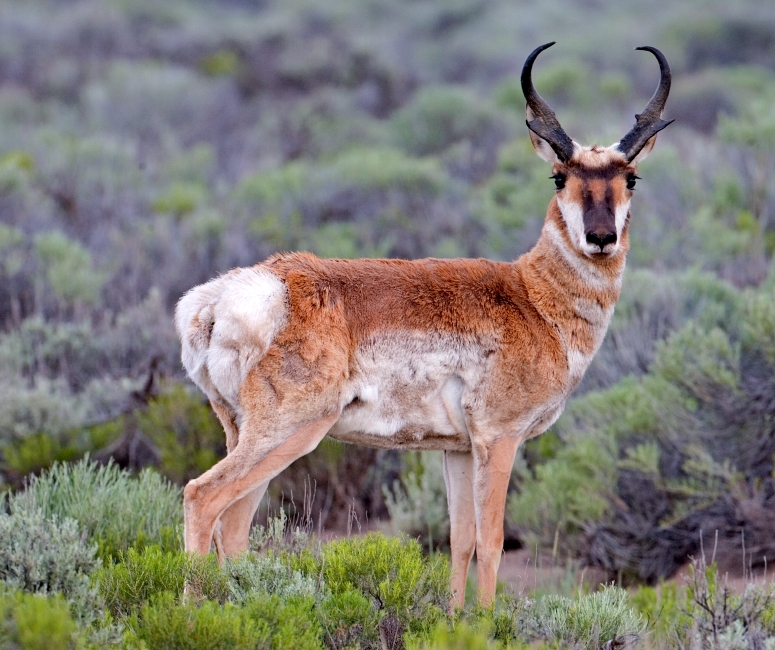Pronghorn Antelope (Antilocapra americana) - Wiki Pronghorn
From Wikipedia, the free encyclopedia
[Photo] Pronghorn Antelope (Antilocapra americana), Cabin Lake Road, Fort Rock, Oregon. Source http://www.naturespicsonline.com/ Date June 2006
The Pronghorn (Antilocapra americana) is the only surviving member of the family Antilocapridae, and the fastest mammal in North America running at speeds of 58 mph (90 km/h). The Pronghorn is also known as the Pronghorn antelope, but is not a true antelope. It is a unique animal with no close relatives. Both the males' and the females' horns are made up of a hairlike substance that grows around a bony core; the outer sheath is shed annually.
Pronghorns have a longer gestation period compared to other North American ungulates. Bands of pronghorns live in open grasslands, gathering into larger herds in the winter. The Pronghorn breeds in mid-September and the "doe" carries her fawn until late May. In comparison, this is around six weeks longer than the Pronghorn's slightly larger distant relative, the whitetail deer.
Pronghorns were brought to scientific notice by the Lewis and Clark Expedition, which found them in what is now South Dakota, USA. The Pronghorn's range extends from southern Saskatchewan and Alberta in Canada to Sonora and Baja California in Mexico. They live on both sides of the Rocky Mountains. The eastern limit of their range is generally the Missouri River in the United States. The subspecies known as the Sonoran Pronghorn (Antilocapra americana sonoriensis) occurs in Arizona and Mexico.
Pronghorns live primarily in grasslands but also in brushland and deserts. They eat cacti, grasses, and forbs, and browse plants.
Pronghorn newborns weigh 5 to 9 lb (2 to 4 kg). Adult male Pronghorns weigh 100 to 145 lb (45 to 60 kg) while females weigh 75 to 100 lb (35 to 45 kg). The main color of adults is brown or tan, with a white rump and belly and two white stripes on the throat. A short dark mane grows along the neck, and males also sport a black mask and black patches on the sides of the neck.
Male Pronghorns have horns about 5 to 17 in long with a prong. Female Pronghorns also grow horns although relatively small and sometimes barely visible. Female horns range from 1 to 6 in (25 to 150 mm) and are straight rather than pronged. Pronghorns have a distinct, musky odor. Males mark territory with a scent gland located on the sides of the head. Pronghorns are commonly called "Prairie Goats", "Speed Goats", or simply "goats" for this reason (as well as their resemblance to domesticated goats.)
The Pronghorn is built for maximum predator evasion through running; its speed is surpassed only by that of the cheetah. It can sustain high speeds longer than cheetahs, however. The top recorded speed was 61 mph (98 km/h). The Pronghorn, although built for speed with an oversized heart and lungs, is a very poor jumper. Their ranges are often affected by sheep ranchers' fence. However, they can be seen going under fences. For this reason the Arizona Antelope Foundation and others are in the process of removing the bottom barbed wire from the fences, and/or installing a barbless bottom wire. The Pronghorn also sports a very large set of eyes that are said to be the equivalent of 8X binoculars, and have a 270 degree field of vision.
By 1908, hunting pressure had reduced the Pronghorn population to about 20,000. Protection of habitat and hunting restrictions have allowed them to recover to 500,000 Pronghorns. Wolves, coyotes and bobcats are the major predators. Golden eagles have been reported to prey on fawns.
Pronghorns are now numerous enough that they exceed the human population in all of Wyoming and parts of northern Colorado. The Pronghorn is widely hunted in western states for purposes of population control and food, as its meat is rich and lean.
Three subspecies are considered endangered in all (A. a. sonoriensis, A. a. peninsularis) or part of their ranges (A. a. mexicana)
http://en.wikipedia.org/wiki/Pronghorn
| The text in this page is based on the copyrighted Wikipedia article shown in above URL. It is used under the GNU Free Documentation License. You may redistribute it, verbatim or modified, providing that you comply with the terms of the GFDL. |
